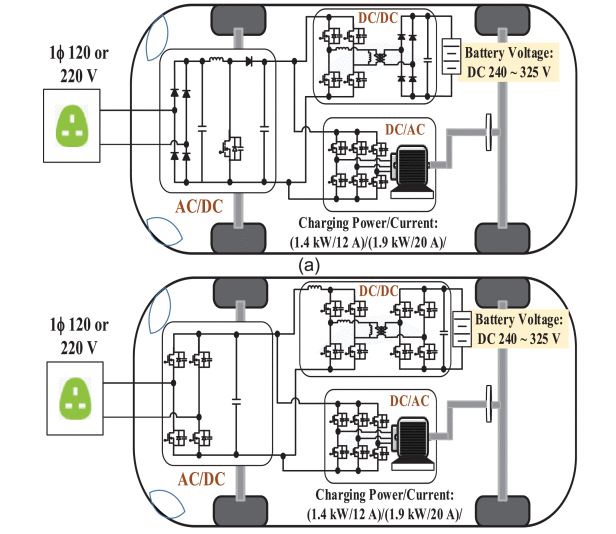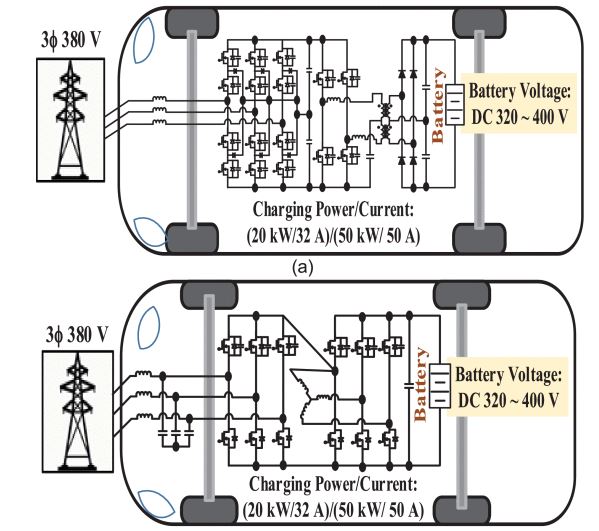The expansion of the infrastructure for charging electric vehicles helps the market's acceptance. An
overview of
the electric vehicle charging technologies is given in this article
The main source of environmental
pollution is the increasing number of fossil
fuel-powered vehicles, including cars, trucks,
buses, motorcycles, and so on. These vehicles
release harmful air pollutants, like carbon
monoxide, nitrogen oxides, and sulphur
dioxide, which worsen air quality and
contribute to global warming. Hazardous
gases endanger the environment and damage
almost every organ system in the human body.
Vehicles like battery electric vehicles (BEVs),
which are safer, cleaner, and more efficient,
are desperately needed in light of these grave
issues.

For battery-electric vehicles, there are two
types of charging methods: wired and
wireless. Over the past few decades, EVs
have drawn more and more attention due to
their promising qualities, such as minimal
pollution, zero greenhouse gas emissions,
and great efficiency. The utilisation of EVs
has significantly improved, according to
recent studies. Improved energy efficiency
and cheaper fuel have led to a rise in EV
sales.
Better fuel economy and lower
emissions make BEVs an environmentally
acceptable transportation option that
satisfies basic criteria. For example, since
2014, the market share of BEVs has grown
dramatically. The batteries and associated
charging technologies have a significant
impact on the efficiency and cost of these
particular BEVs. Businesses are investing
more extensively in their BEV research in
order to maintain their growth rates.

This paper provides an extensive assessment of the most recent developments in BEV charging
systems, including both wired and wireless charging. First, the two types of wired charging
technologies—direct charging via an off-board charger and indirect charging (AC) via an
OBC—as well as their widely used topologies are given. The current state of wireless charging
technologies for BEVs is then thoroughly covered. Additionally, this document lists the top
businesses using both technologies. Lastly, it looks at these technologies' industrial applications
and future research prospects
EV batteries that use AC charging technologies are not charged directly; instead, the onboard charger (OBC) that powers the battery charges the battery. Due to the internal placement of the conversion unit—which changes AC into DC—these technologies increase the overall weight of the system. They are usually charged with either the three-phase (3ϕ) onboard fast charging system or the single-phase (1ϕ) onboard slow charging system


EV batteries that use AC charging technologies are not charged directly; instead, the onboard
charger (OBC) that powers the battery charges the battery. Due to the internal placement of the
conversion unit—which changes AC into DC—these technologies increase the overall weight
of the system. They are usually charged with either the three-phase (3ϕ) onboard fast charging
system or the single-phase (1ϕ) onboard slow charging system
DC charging solutions offer quick charging capabilities by directly charging the battery, in
contrast to AC charging techniques. Two other subgroups of DC charging methods are offboard rapid charging systems and off-board fast charging systems. Such technologies can lead
to a reduction in the total size and weight of the driving system in the car because the conversion
unit is separate from the vehicle.
High-capacity batteries can now be charged in less than an hour with the help of modern DC
charging techniques. The operation of the wired and wireless charging system for BEVs is
depicted. This figure illustrates how the OBC is primarily integrated into the BEV. It is made
up of a power factor correction circuit, a full-bridge rectifier, and a chopper that functions
similarly to a dual-active bridge to charge the battery indirectly. The off-board charger, which
feeds the battery directly, is situated outside the BEV at a charging station, in contrast to the
onboard charger.
The cost of installing a battery management system (BMS) is higher, and it does not offer
the flexibility of numerous battery charging locations. Although there have been several notable
and positive developments in wired charging systems, one of their primary drawbacks is that
they are inflexible, which limits the locations in which they may be charged. The difficult
requirements for reliability and safety should also be taken into account while evaluating the
BMS.

For battery-electric vehicles, there are two
types of charging methods: wired and
wireless. Over the past few decades, EVs
have drawn more and more attention due to
their promising qualities, such as minimal
pollution, zero greenhouse gas emissions,
and great efficiency. The utilisation of EVs
has significantly improved, according to
recent studies. Improved energy efficiency
and cheaper fuel have led to a rise in EV
sales.
Better fuel economy and lower
emissions make BEVs an environmentally
acceptable transportation option that
satisfies basic criteria. For example, since
2014, the market share of BEVs has grown
dramatically. The batteries and associated
charging technologies have a significant
impact on the efficiency and cost of these
particular BEVs. Businesses are investing
more extensively in their BEV research in
order to maintain their growth rates.
EV batteries that use AC charging technologies are not charged directly; instead, the onboard
charger (OBC) that powers the battery charges the battery. Due to the internal placement of the
conversion unit—which changes AC into DC—these technologies increase the overall weight
of the system. They are usually charged with either the three-phase (3ϕ) onboard fast charging
system or the single-phase (1ϕ) onboard slow charging system
The so-called rapid charging technologies are an extension of fast charging technologies that require higher power and charging current With these charging methods, the battery of BEVs with DC 320 ∼ 500 V can be charged up to 80% in 15 minutes because the charging period is faster. DC 480 V and 250 kW power supply one of the most well-known rapid chargers, which is produced by Tesla. Around 16,013 superchargers at 1,826 charging stations worldwide were successfully run by Tesla as of March 2020 for a variety of BEV models, including the Model S, 3, X, and Y .



One of the more recent and
affordable near-field charging
solutions for contemporary
transportation is inductive charging,
which involves transferring
electricity from a transmitter pad to
a receiver pad via an
electromagnetic field, as illustrated.

One of the most important factors to take into account in these systems is maximising power
transfer while maintaining a high level of efficiency, both in terms of design and operation.
Furthermore, controlling the EV power bus voltage is crucial for achieving a long battery
lifetime. This can be done by controlling the switching frequency and conversion ratio of the
secondary-side converter (such as a full-bridge or dual-active bridge DC-DC converter at the
receiver) and the primary-side converter (such as a high-frequency (HF) AC-AC converter at
the transmitter pad) at the same time.
EV batteries that use AC charging technologies are not charged directly; instead, the onboard charger (OBC) that powers the battery charges the battery. Due to the internal placement of the conversion unit—which changes AC into DC—these technologies increase the overall weight of the system. They are usually charged with either the three-phase (3ϕ) onboard fast charging system or the single-phase (1ϕ) onboard slow charging system

These two plates act like two capacitors in
parallel connection, so an electric field can be
generated between them, resulting in the
induction of electrical current in the receiver
pad . This induced current is equivalent to the
rate of change of the electric field between
the transmitter and receiver pads. Thus,
power converters such as resonant-based

converters can be utilized to increase the rate of the electric field by elevating the frequency
provided by the utility grid. Their power transfer capability, distance, and maximum efficiency
can reach up to 7 kW, 12 cm, and 80%, respectively
Though more research remains to be done, far-field charging technologies—such as laser, microwave, and radio wave charging—are anticipated to dominate wireless charging in the future. In the future, far-field charging techniques are thought to be the best choice for EV charging. However, one of the main issues with wireless charging systems is that they can easily spiral out of control if the link between the transmitter and the receiver is lost.


TUCKER CHATBOT
Typically replies within an min